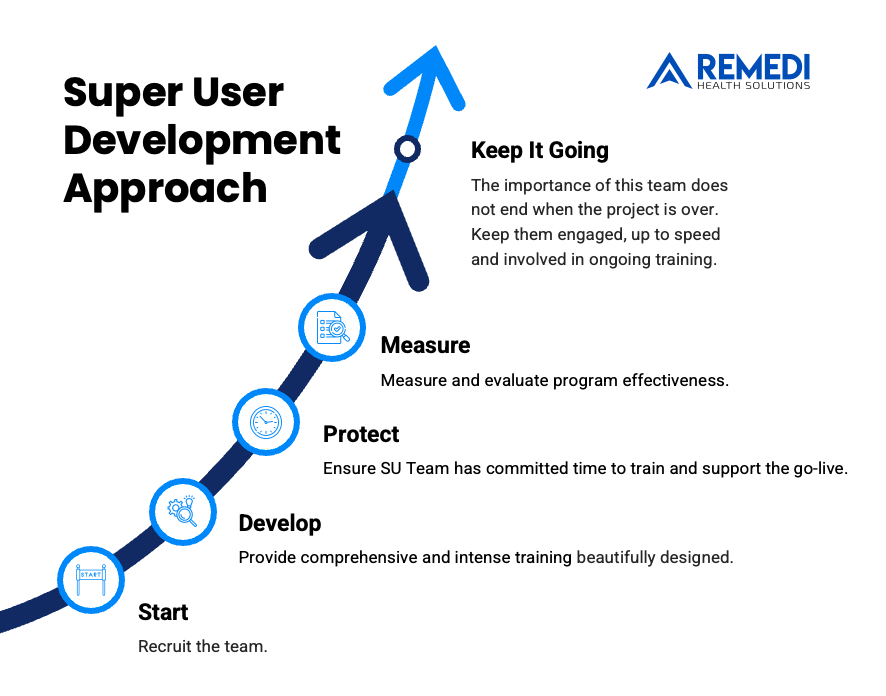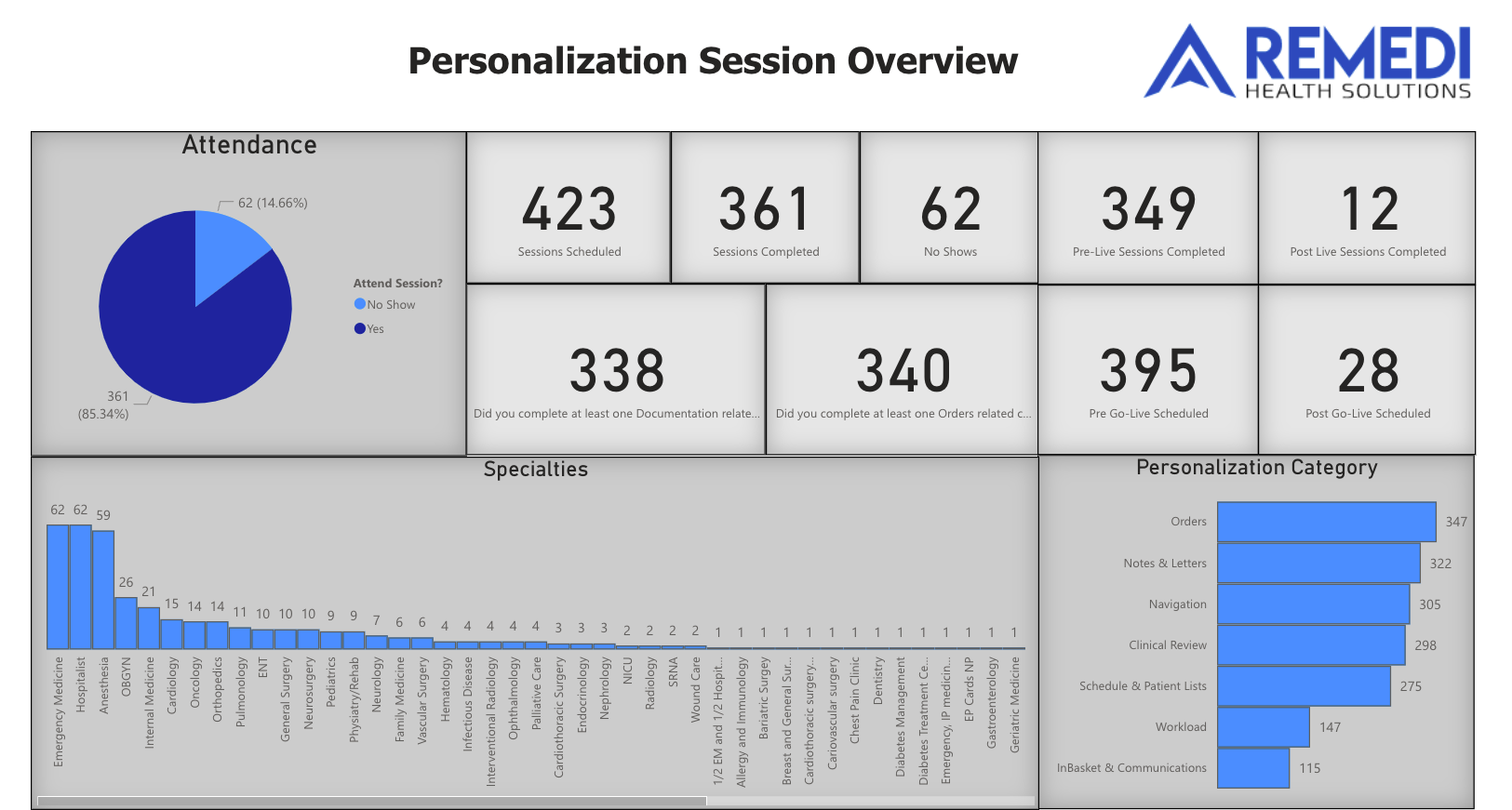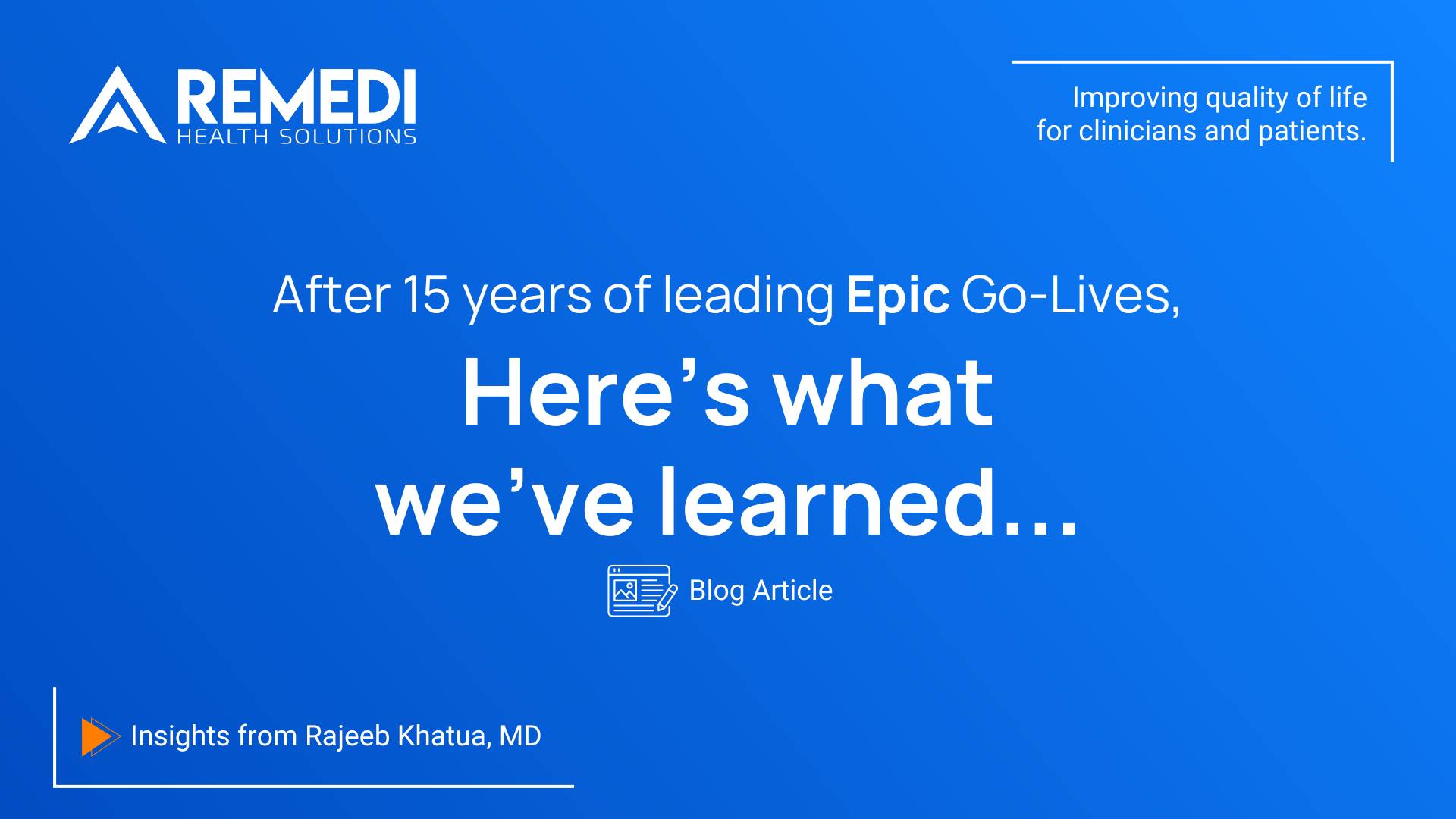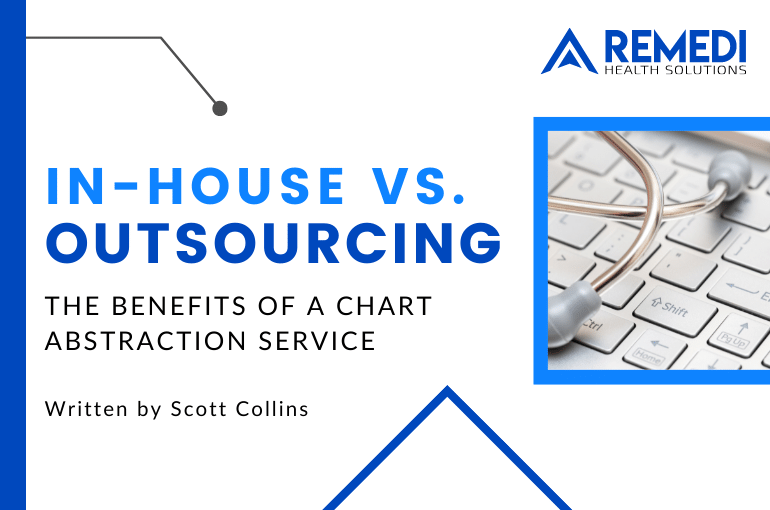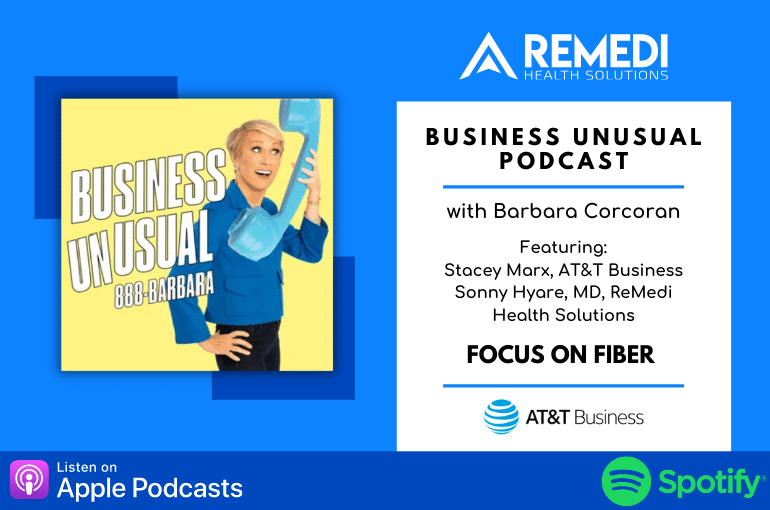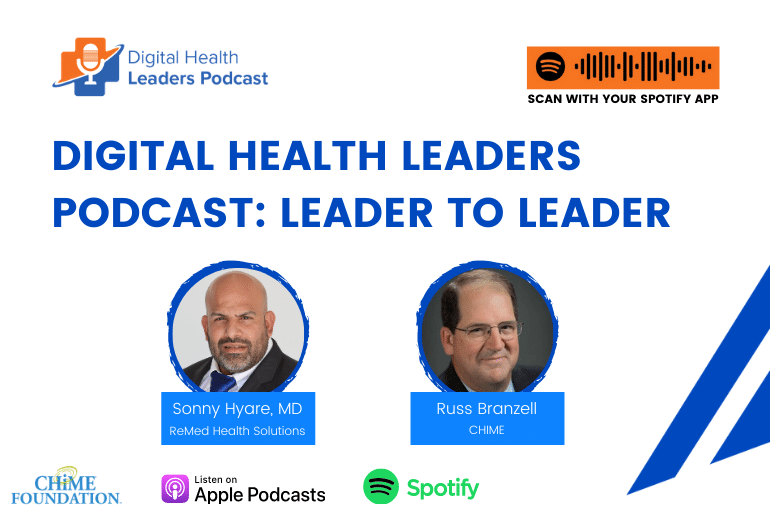Our very own Chief Executive Officer, Sonny Hyare, MD sat down with College of Healthcare Information Management Executives (CHIME) CEO, Ruzz Branzell (virtually, of course) to discuss the state of EHR and EHR Go-lives amid the COVD-19 pandemic, ReMedi’s modern virtual command center, and the evolution of Sonny’s career in health informatics.
In this candid conversation between two veteran healthcare leaders, Sonny and Russ share their knowledge, challenges, best practices, and ideas for helping to transform health and care on a global level, including:
- The evolution of of a successful career in health informatics
- Electronic health records (EHR) in the digital healthcare landscape
- The response to COVID-19, launching a modern Virtual Command Center
- Future of the EHR Go-Live and hybrid virtual strategy
- A look into the commitment to diversity in the workplace at ReMedi
Listen to the show here, and follow the transcript below.
Listen on Apple Podcasts
Transcript:
Russ:
Today we have one of those great industry, digital health superstars that we all like to hear from. If you ever want to look at a cool LinkedIn profile, this is one of those guys you want to go see he’s an entrepreneur, he’s a medical doctor, he’s a medical director in the past. He’s a longstanding physician informaticist. And if all that’s not enough, he just decided to start his own company and help people with the really hard issues in the world. It is with an absolute pleasure that we introduce, Sonny Hyare. He is the CEO and president of ReMedi Health Solutions.
Welcome to our leader leader podcast.
Sonny:
Thank you, Russ. I’m so happy and grateful to be here.
Russ:
Well, first and foremost we’re, kind of in a crazy world. COVID craziness comes down a little, back on the roller coaster ride back up again.
How are you, how are your family, how is your team doing during these kind of crazy days we’re living in?
Sonny:
It has been crazy. I mean, going back to February and March and you know, from a family standpoint, I almost feel like it’s been a little bit of a blessing in disguise. I got two young boys – two and one – and the ability to spend the time that I got to spend with them, I don’t believe would have happened if COVID hadn’t happened. Which is taking a positive out of all the negative. It’s been good. And then the other portion of it is that we bought a house across the street from my parents. We didn’t have to worry about not seeing them or going that lengthy time that a lot of people did with their families. So it was just everyone just going back and forth, keeping it just to that. So it’s been good. The family is good. I’m sure everyone is done with it, just like the rest of the world. Especially with it coming back the way it’s coming back right now. But overall, everyone is good. We have a 99 year old grandmother that lives with us as well. So that has been the ultimate kind of precautionary steps that we’ve been taking to make sure that she is good. And I think that’s what’s kept us all good.
Russ:
Well, you know, I mentioned in your introduction, you know, if there’s an interesting person you want to look at their profile, it’s you on LinkedIn. I’ve gotten to know you a little bit. You got little ones at home, you did medical school overseas where you had to learn a foreign language. You have multiple foreign languages. You’ve done all that.
Tell us about how you got to this point, and a couple of those cool little facts along the way.
Sonny:
So it’s, it is an interesting ride. I was born and raised in Houston and you know, my parents came from India in 1978. And so then I was born in Houston. Then I, when I turned seventeen, instead of going to the normal University of Texas or Texas A&M, I actually ended up going out to Europe, Hungary to be exact. So I left that I left at seventeen did my undergrad there as well as started my medical school there, was there for about five and a half years. And then from there, then you transition over to the States where you do your rotations. I ended up in Chicago. From Chicago, I ended up doing my training out there. And then I started this kind of this healthcare IT space back in almost almost 10 years ago, maybe 11 now.
Sonny (cont’d):
It it was interesting because I was just looking on a website for a contract shift. There was a hospital in California, Beverly Hills, saying we’re looking for 40 attendings to come and provide support for an Epic rollout. So, this sounds interesting. Let me let me see what this is about. I feel like after that is where all this kind of led to; this entire informatics, EMR, and where we sit today – why I was able to create something like ReMedi. It’s difficult for me to tell people what companies I worked for. But this being CHIME, I started my career with a company called Encore. I moved over to a company called Clinovations, which then I was part of Clinovations when they were acquired by the Advisory Board Company. And right before Advisory Board Company was acquired by Optum, I started ReMedi. I feel like everyone that’s part of CHIME is pretty familiar with those company names.
Russ:
Wow. I mean, that’s just absolutely incredible. So you speak Hungarian, Hindi and English.
Sonny:
I do. I speak Hungarian. I learned Hungarian while I was in Hungary, and I actually speak Punjabi, which is a dialect of Hindi. So that is that is what my parents spoke. I actually learned Punjabi even before I learned English. Even though I was born here, I think I was in ESL until about second grade, til a teacher finally asked why I was in ESL. Which was funny, but English was a second language for the first first couple of years of elementary for me. I think the adoption or the thought process for my parents was, let’s teach him this language because he’s already going to learn English.
Russ:
I mean, that’s crazy. I have enough trouble with English. I can’t imagine two other languages. I wouldn’t break out different words in a whole sentence and no one ever understand, especially when I came out of Texas. People didn’t understand me real well there either, so that’s fine. Hey, let’s, let’s talk a little bit about ReMedi. What is ReMedi? It sounds like a medicine. That’s not what it is. What is ReMedi?
Sonny:
Well ReMedi is what we were trying to serve: how do we provide a remedy for the providers who are struggling with the EHR? With all the changes, whether it be regulatory, or whether it be or whether it be reimbursements, and things like that. Our core team is really based on MDs. A lot of our physicians have have clinical backgrounds as well as consulting backgrounds. So my background is from Advisory Board and Optum, most of the physicians that we work with have that similar type of background. The premise behind it was essentially made up of: how do we make physicians lives easier?
Sonny:
When we look at hospitals, they actually only have one billable resource. Meaning there’s only one person that can put a CPT code in. That’s usually one of the clinicians, providers, mid-levels, whatever it may be. So we wanted to form something that would cater to that group specifically. We believe that most IT initiatives within the hospital should be a clinically driven IT project. I think that was kind of the premise of where ReMedi came about. What ReMedi wanted to do was very niche, very toward the physician piece for these projects.
Russ:
So if, if I understood the facts correctly, everybody else is sending everybody home. As COVID is launching, you brought everybody into an office at the exact same time.
Sonny:
Oh yes. I think we’re the only one in the world that did this. This was a different choice. I remember talking with with our team and saying, this is what I’m thinking we should do. What do you think? Everyone kind of looked at me a little bit crazy. This was obviously on Zoom. It was somethin we knew was the only way we could continue moving forward, not only as a company, but getting the hospitals what they needed during this time. We had to make a change. So we built out this Virtual Command Center, 18,000 square feet in the city of Houston. We brought in a bunch of computers and got everyone set up. We made sure everything was meeting the CDC guidelines from a social distancing protocol. From getting everything cleaned to just about everything. We tried to replicate what Massachusetts does, because we found that Massachusetts was one of the strictest states on these things. We brought people into the office instead of sending people home to work from home, the exact opposite.
Russ:
You did all that. And how many got COVID?
Sonny:
None. Zero. We had zero COVID cases and we had everyone have COVID test beforehand and after so the last remaining two members in our team just went to go get COVID tested today. So fingers crossed. We’ll find out probably before this podcast ends, that they were negative.
Russ:
That’s awesome. I mean, for all of our listeners out there, call Sonny, find out how he did it if you really want to keep your teams in their offices and that kind of stuff. I know so many of you were ready to ring people back, but it looks like we’re going to be extended remote for quite a while. So Sonny will give you all the answers. I know he will. He’s a, he’s a great guy to share like that. So not only did you do that, the reason you brought them in was to essentially support a gigantic remote go-live at the exact same time, which you had also never done. Tell us about that experience of trying to manage something so complex, hands-on support, and you did it remote.
Sonny:
So I think the premise was, we’ve seen it, we’ve been involved with [implementations] for such a long time. How do we improve on it? When we started going through this process, we wanted to make sure that we were not a help desk model. That was something that we kept talking about. We don’t want someone to pick up the phone. We don’t want someone to call in a question, how do we make this real time? How do we make it feel like somebody is there? We went through the steps and the processes of going in and creating this, and making it as personal as we could. Now, I believe that physicians got accustomed because of COVID using telehealth, Zoom, Microsoft Teams, whatever they were using at their hospitals.
Sonny:
It gave us the ability to push this through. We got a bunch of tablets, like, a lot of tablets. And we, we sent them out to the client and strategically placed them in various spots in the clinic and hospitals. From there, it gave our support in Houston the ability to actually be seen and talk and have conversations with the end-user. That was one of the big premises behind this. How do we still grow that relationship? Because they’re going to be with them for two, three, four weeks, whatever it may be. And then the second part of it was, how do we give leadership a bird’s eye view on exactly what’s going on in each one of these clinics or each one of these departments? And we were able to essentially gather every single data piece from an end-user standpoint. What their name was, what their question was, what their problem was, how to get resolved with their ticket, et cetera.
Sonny:
When we’d run these reports, we could look at: here’s six clinics that you didn’t hear anything from, and you’ll see what they were doing from a utilization standpoint. Here’s three clinics that we were hearing the most complaints from, and now we know exactly why they were complaining. The leadership of this hospital loved the fact that we were handing them these reports. Because it really pinpointed what they needed to do and what they needed to take care of. I think that was the biggest thing was once again, we were using data on a daily basis to drive how we want to set up the next day’s support, the next day’s support, and the next day’s support.
Russ:
Wow. And obviously nobody’s going back to anything at least quite yet, but, you know, there’s promise for vaccine, there’s promise for some other stuff. Let’s just say from the virus perspective, things normalized out a little bit, the vaccine was available. Do you think you will go back to a hundred percent on premise, you will go stay a hundred percent virtual, some kind of hybrid in between?
What do you think the future looks like for the model that you’ve created?
Sonny:
I think definitely not a hundred percent. I don’t see a reason for it. I think a hybrid model. A hybrid model was something that we kind of did at the last client. The hybrid model was that our physicians were on the ground and supporting whether the clinics or the hospital. Our actual support was in Houston. I think that’s a model that we’ll keep because of the fact that sometimes things happen. I called that team the physician crisis management team. We needed them to be there. For any particular reason, everyone thinks, I think its the best analogy: the backup quarterback is always better. I felt like the team on site was the backup quarterback.
Sonny:
I don’t see us going back. I think this is the future. This is what it should be. Not only are we taking away an influx of people coming from all over the country; we’re actually getting data that shows what’s happening on a daily basis that was never provided before. The other part is it’s just so much cheaper for hospitals to do it this way. You have this significant amount of costs that gets cut not only from an expense standpoint. All of a sudden we have five geographical locations for sites for a system, and they need maybe a little bit of support at each one. The old model, was we gotta send five people out there and let people sit around and answer questions. The new model is that we just need one person and there’s five tablets across the board, and now they have access to them whenever they need it and whenever they want it. So I can’t see us going back to the old way.
Russ:
Well, there’s no doubt. It won’t be anytime soon, even if you wanted to a little bit with what seems to be happening around the country. Now, one of the things you did to make that work is you stood up your own Virtual Command Center for them.
So tell us what your Virtual Command Center is, and what its primary purpose was.
Sonny:
So the project that just happened, as much as we wanted people to be at home and work from home, this was more or less in our eyes the first of its kind. We needed to essentially have a little bit more control on what was happening and how we could essentially manage this amount of people and this amount of end-users. So, yeah. I still laugh when I think about it, because we did this in a pandemic. We found the right space. We found what we needed from a size standpoint, and luckily we live in Texas.
So that saying is true. Everything is bigger in Texas.
We were able to find a large space that would accommodate exactly the number of people we were looking for. And so we were looking for about 110 people to be set up. And it was quick to get all the, the computers, all the softwares that was needed, but it was the space that was very, very key for us. And once we were able to lock that down, we had this command center up and running in about a six week period.
Russ:
Wow. Did you run 24/7 or what was it?
Sonny:
No, it was not 24/7. It was 12 hours a day. And then there was some support that was 24/7. But those folks were actually doing that from home. So the actual command center itself was 6:00 AM to 6:00 PM, which for Massachusetts, that was 7:00 PM, 7:00 AM to 7:00 PM.
Russ:
So, so obviously this organization in Massachusetts did very well doing this virtually, and was successfully able to go-live. What would be your recommendation for some of these organizations that say, you know, I’m just going to hold back right now because we can’t get people onsite? Obviously you’ve proven you can do this virtually, but what are the things they should consider when maybe considering doing this virtually?
Sonny:
I think this is exactly why it came about. We, we were having this conversation with our client: we can’t postpone, we’ve already made the investment. Coming from the client standpoint, not ReMedi, they came to us and said, what can we do to still make this happen in October? They had already postponed from June. They were looking at postponing from October. We came back with them with what we’re thinking. Boston being a little bit more progressive than most, they’re always looking to do new things and be that beta kind of test site. They gave us the green light. So we’re very blessed that we had a client that trusted us, that believed in us, and let us do this.
Sonny:
When I look now at what we were able to do, we had a lot of lessons learned. We had a lot of a lot of things that worked exactly how we wanted them to work. Then some things we know we can improve on. And some things we were like, hey, we don’t need this next time. I think if people are actually looking at the is the model, this should be happening with or without a pandemic.
I think the amount of information and analytics that’s collected is second to none.
There’s just value on that by itself. The second thing we learned is we don’t need the amount of resources that was needed before. We just don’t. We are definitely on the end of quality versus quantity, and that was our thought process behind it.
Sonny:
How far can we kind of push this threshold on the ratio of support versus end-users? I feel like we succeeded at that, I feel like the model and the number that we have is far better than what we had thought.
When I look at hospitals or CIOs that are looking to make this decision, I don’t think they should postpone.
I think they should do this model. And I just read on LinkedIn yesterday that Oschner, which, we don’t have any working relationship with. They did a similar model to what we did in an upgrade, and they did it internally. So the fact that Oschner did it and kind of replicated, or not replicated, they thought of it the same time we did. It gave us a little bit of excitement. And you know, we’ve never talked with this institution. They never talked with us, but both of us came up with the same idea and both of us did it at the same time.
Russ:
Wow. Well, I think it is.
During tough times like this, leaders lead, and you all figured this out and that’s leadership, that’s quite impressive.
And, you know, to that point, obviously you are a significant, innovative leader, and of all the things that you’ve done along the way, going to medical school, all the different steps along and now, entrepreneur, CEO, running your own company, you know, that requires you to constantly be on your best and your top of your game.
How do you personally view growth and how do you make sure you’re the best you can be?
Sonny:
Yeah. For me, personally, growing as a leader is just to continuously read. I end up reading, listen to podcasts, like the one we’re on today, which to me is a good feeling that I’ve been listening to these podcasts, and now I actually get to be someone that participates in it. These are the things that help me grow and continue to stay in front of what is happening in our industry. Another thing is that my regimen has completely changed from what it used to be five years ago to what it is now. I don’t know if it was the factor of having kids. I don’t know if it was the factor of starting my own company, and then actually running a company? So my routine is I get up by 5:30 in the morning and I have to work out. That’s a huge part of my life. That’s a huge part of my family. Before I work, I get ready real quick, and my kids wake up, and then usually I have a little bit of breakfast with the family. Talk to them, have some jokes, let my wife have some adult conversations, because she’s the true champion. She put her career on pause to really take care of these boys, and allow me to do what I wanted to do. From there I leave to the office. We have two offices, one in the city and one closer to home. I come to the one in the city and I spend about seven to eight hours here, working with the team, taking any calls that we need to take.
Sonny:
I find myself leaving here about 4:30 to go home and be with the kids for about two ot three hours. I help my wife, feed them, give them baths, get all that good stuff going. When they go to sleep about 7:30, I head back to the office around 8:30 PM. Usually work anywhere between 8:30 till about one or 2:00 AM, depending on what day it is. That is the only way I have figured out so far of how to get everything accomplished that I want to. Family is a big part of our core values, and I can’t imagine not seeing them or spending a significant amount of time with them each day.
Russ:
What I love about that, and we talk about this in our own internal mentorship class and our leadership programs that we teach, is this concept of intentionality. If you are not intentional about it, you will be consumed by somebody else’s intentions. And so I love that because you have your own thoughts and requirements. That’s absolutely great leadership. One of the things that’s a great challenge, and obviously you can see it from your own perspective. You also see it running a company, is there’s obviously a lot of social distress going on in our society today, A really heightened awareness, and appropriately so. Inequities of programs of that don’t provide the best opportunities for everybody that’s there. You’re in one of the most interesting cities in the country. It’s very, very diverse. It’s not just Hispanic, black, white. It is all kinds of stuff. Houston is one of the most diverse cities in the nation. SO you running a company the way you do, I’d love to get your perspective on workplace equalities, the things you’re trying to deal with, because this is such an important topic in today’s society.
Sonny:
It is. It’s it’s been a big one for awhile. You’re spot on about Houston. Houston is, I believe last I read, most diverse, even more diverse than New York, which I thought was impossible. One of the things I always like to talk about is my father’s story. My father came here in 1978 and started working for a company as a data processor. I think it was ’79 was when he started working for that company. At the same time, he was working for Hertz as well. That was his night job. He would have to return cars back and forth. And you fast forward 20 years, my father became the president and CEO of that company and ran that company for another 15 years before he retired.
Sonny:
This was in the oil and gas industry, which is a lot different than healthcare. So I was able to take all of his core values and work ethics, and implement them into what we were doing here at ReMedi. When we look over our group, it’s a very diverse group. We feel like by having that diversity, you learn so much more. Different ideas come about and things like that. I don’t think it was something that we actually sat down and thought about; it all came into fruition on its own. I think if you have that mindset, if you’re not looking for it, you’ll be surprised by what you get.
Russ:
Wow. So as you approach this in the workplace, and especially a company like yours, because you’re, you’re not, and I don’t say this in any way derogatory, you’re not a traditional consulting company, even though you do some of the same functions, you really have a niche. You probably are constantly looking for those people who want to do something a little bit differently. What kind of people do you look for when you’re looking for people on your team?
Sonny:
Different backgrounds. We’re strong on the MD portion of it. We have a strong pool of physicians. One of the things that when I first started this company… this is actually a funny story. I brought my brother into this company. My brother is Geophysicist a by trade. So you can only imagine what our parents were thinking when they had they had their eldest son, that was a physician who decided not going to do clinical practice, going into healthcare IT. Now he’s taking their younger son who was a Geophysicist by trade saying, hey, I need help. Can you come over here? And all they thought we were doing was literally teaching doctors how to use a software. Just a few days ago there was an article printed in our local paper, the Houston Chronicle, about what ReMedi was doing. And my folks being here for 40 plus years, the Chronicle is something they’ve read every single day. So they were very happy and very proud about that. It made us feel good and at least they were like, alright… they stopped asking those questions. They’re like, just keep doing what you’re doing.
Sonny:
Our group consists of people with finance backgrounds, people from marketing backgrounds, people that have been involved also within the EHR space. I think with me being in this for 11 years, I was able to handpick some of these folks that I had seen had done such a good job elsewhere, and were just looking for the opportunity to finally do something a little bit more innovative, a little bit more different. Bringing a lot of quality to each aspect. I think that’s what I love about our team. They’ve been in this industry; part of them have been in this industry. The other part are MDs. And then I have this younger group, who just have the greatest ideas. I feel like it’s on us to be able to execute these ideas. It’s just a great group we have here.
Russ:
So obviously you’re helping, you know, one of your primary targets is to help these physicians utilize the system, get more benefit and all these other things, but we still just see this massive amount of literature, podcasts, entire conferences, about physician burnout, about lack of usability, those types of things. As you look at that from an industry perspective, and really what you all do is try to make this better. Do you think this is as the generations turn and nothing against any generation, it’s just going to become the norm and, you know, it’ll just be what they do to do their jobs? Or do you just think this is in some cases, it has nothing to do with generation it’s just bad training and, or maybe bad software and we just need to get that side better where where’s the answer for at least today?
Sonny:
I think it’s a mix of both. I think when we look back, we did see training that wasn’t sufficient. We saw limitations from a software standpoint, but then on the flip side, we see people have adopted the software, understand what they want to do, and then are able to make those changes. Even within their institution, or if they can make it to the bigger vendors. I think that it’s a little bit, it’s both. I know the bigger vendors are trying to make these changes and trying to make the usability better. I also think that there’s a lack of knowledge on what the system can actually do.
Russ:
Wow. Well, a couple of more quick questions as our time’s wrapping up here. Obviously one of the things you’re seeing from the frontline working with these leaders in this positions and organizations is that the technology is being adopted. Digital health is a reality. And really kind of the, the, the buzzword of the last few years has been, we’re starting to “innovate” and “transform”. What do you personally see that occurring in these next few steps, maybe 18, 24, 36 months? What do you see that looking like?
Sonny:
I think telehealth is here to stay.
It’s unfortunate that we needed a pandemic to get it started, but it is here. The other thing that I would like to see, and I feel like as a need: how is interoperability really going to work amongst the different institutions? How is this information going to be seamless? Are we going to see the, the big firms out of San Francisco create this for us? Or are we going to see the hospital systems work on this and truly create a solution that the government is kind of is putting out there. I think that there’s so much technology out there, and we need to start to utilize it. Even when we sat down to do this Virtual Command Center, there wasn’t a single piece of tech that we had to go out and create. It was all out there. We want to start seeing it. I think a lot of the bigger hospitals have kind of put in these innovation hubs per se, into their hospitals to allow vendors to come and test these technologies and see how it works and things like that. So I think the future and the innovation is limitless. We just need to get the adoption and the execution better.
Russ:
So the last question for you is, as a leader in healthcare, helping us on this digital journey, we’re all shaped by other people and experiences and education, but we all kind of have our go-to things that kind of drive us every day. Whether they’re sayings or principles or whatever it is. So what are your one or two, maybe three things that really everyday you go, here are the things I live by?
Sonny:
Be punctual. Be on time. Be willing to learn and work hard. Those are the three things that we we emphasize here at ReMedi over and over. Those are the only three things I asked for. I think if you get those three things, the sky’s the limit.
Russ:
Yeah. I don’t even know who said the quote. Once I heard this thing, “no one’s ever gone hungry showing up on time and working hard.”
Russ:
So that’s great. You know, again, sometimes simplicity is the right answer. Those are all three things that truly are core to people’s success. With that being said, Sonny, again, it’s an amazing time we got to spend together. I appreciate so much you sharing some of your wisdom, some of your learnings. And again, just being willing to share as a leader in our industry.
Even if a little bit of it might be in some of your trade secrets, you know, the secret really is you as a leader in your organization. So thank you again for being on our program.
Sonny:
Thank you. Thank you, Russ. Thank you. CHIME for having me.
Russ:
Well, thank you to our listeners for listening to this episode of our Leader to Leader podcast program. As always, you can find us on chimecentral.org/media, or listen to any of our programs on Apple or Spotify. For now, especially as we see the COVID pandemic continuing to get worse, please take care, stay safe, and stay home if you can. If you don’t, wear your mask. Be safe, and God bless.
